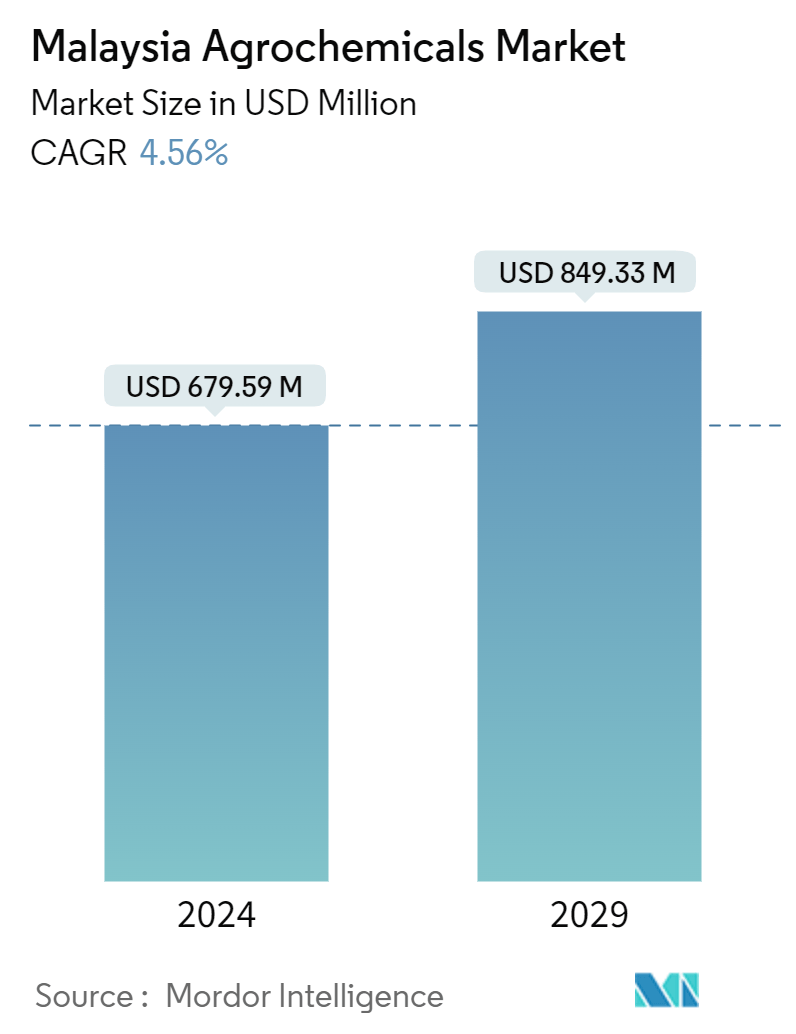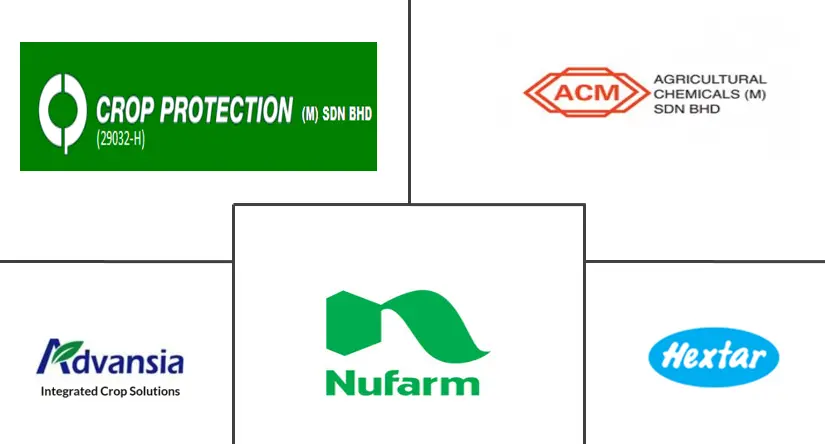Market Size of Malaysia Agrochemicals Industry

| Study Period | 2019 - 2029 |
| Base Year For Estimation | 2023 |
| Market Size (2024) | USD 679.59 Million |
| Market Size (2029) | USD 849.33 Million |
| CAGR (2024 - 2029) | 4.56 % |
| Market Concentration | Low |
Major Players
*Disclaimer: Major Players sorted in no particular order |
Malaysia Agrochemicals Market Analysis
The Malaysia Agrochemicals Market size is estimated at USD 679.59 million in 2024, and is expected to reach USD 849.33 million by 2029, growing at a CAGR of 4.56% during the forecast period (2024-2029).
Malaysia is one of the most developed markets in Southeast Asia. In 2022, the agriculture industry in Malaysia contributed 6.6% to the country's gross domestic product (GDP). In Malaysia, agriculture is an important industry, as it ensures food security and increases income levels in rural areas. Increasing population statistics and declining arable land are responsible for maintaining adequacy in agricultural practices, ensuring more significant utilization of agrochemical products in the areas that were ignored in the past.
Moreover, rice is a staple food among Malaysians and one of the most important food crops in the country. According to the Food and Agricultural Organization, in 2021, Malaysia produced 1.68 million metric tons of rice, an increase of around 180 thousand metric tons compared to the previous year. This growing production trend resulted in extensive pesticide usage to minimize pests and maximize profit.
The use of agrochemicals has been growing significantly in the country, particularly for pesticides and fertilizer consumption, as modern practices are being utilized in fields. The growth of the agrochemical industry also depends on the rapid expansion of areas under oil palm and rubber plantations. Malaysia's oil palm industry was the country's primary agricultural sector and contributed 2.4% to its overall gross domestic product (GDP) in 2022. According to the FAO, in 2021, 45,670 metric tons of pesticides were used in Malaysia for agricultural purposes, an increase from around 36,000 metric tons the year before.
Many local enterprises in Malaysia are expanding into the agricultural sector. The nation is also evolving into a regional hub for pesticide exports, as active chemicals are transferred here to be transformed into fresh goods before being reexported to surrounding countries. Additionally, the increasing government initiatives are becoming a driving factor for market growth. For instance, in 2022, the Malaysian Ministry of Agriculture and Food Industries (MAFI) was requested by Pesticide Action Network Asia Pacific (PANAP) to consider providing paddy farmers with help for safer, non-chemical pesticide alternatives that can benefit farmers' health. Therefore, the increase in consumption of highly economical crops, food demand, and government support is expected to aid market growth during the forecast period.
Malaysia Agrochemicals Industry Segmentation
Agrochemicals are chemical products, including fertilizers, adjuvants, pesticides (insecticides, herbicides, fungicides, and nematicides), and plant growth regulators, which are used in agriculture to enhance crop productivity and protect crops from pests, insects, weeds, and fungi. The Malaysian agrochemicals market is segmented by product type (fertilizers, pesticides, adjuvants, and plant growth regulators) and application (crop-based [grains and cereals, fruits and vegetables, and oilseeds and pulses] and non-crop-based [oil palm, rubber, turf ornamental grass, and other crops]). The report offers market size and forecasts in terms of value (USD) and volume (metric tons).
| By Product Type | |
| Fertilizers | |
| Pesticides | |
| Adjuvants | |
| Plant Growth Regulators |
| By Application | ||||||
| ||||||
|
Malaysia Agrochemicals Market Size Summary
The agrochemical market in Malaysia is poised for growth, driven by the country's reliance on agriculture for food security and economic stability. As urbanization leads to a decline in arable land, the demand for agrochemicals, particularly fertilizers and pesticides, is increasing to enhance crop productivity. The oil palm and rubber industries, which are significant consumers of agrochemicals, play a crucial role in this market expansion. The government's initiatives to support agricultural productivity and the country's position as a regional hub for pesticide exports further bolster the market's growth prospects. Local enterprises are also expanding their presence in the agricultural sector, contributing to the increasing utilization of agrochemicals.
The Malaysian government's efforts to stabilize and grow the agricultural sector are evident through various measures, including the introduction of the Fertilizer Act and international collaborations like the ARISE Plus Malaysia project. These initiatives aim to improve the efficiency and regulation of agrochemicals, addressing existing challenges and enhancing production capabilities. The market is characterized by fragmentation, with key players engaging in strategic partnerships, innovations, and expansions to strengthen their market share. As the demand for sustainable and efficient agricultural practices rises, the agrochemical market in Malaysia is expected to experience significant growth during the forecast period.
Malaysia Agrochemicals Market Size - Table of Contents
-
1. MARKET DYNAMICS
-
1.1 Market Overview
-
1.2 Market Drivers
-
1.2.1 Recurring Instances of Pests and Diseases on Crops
-
1.2.2 Increasing Demand for Food and Agricultural Productivity
-
1.2.3 Reduction in Agricultural Land Area
-
-
1.3 Market Restraints
-
1.3.1 Stringent Regulations on Agrochemicals Usage
-
1.3.2 Introduction of Gene Editing Technology
-
-
1.4 Porter's Five Forces Analysis
-
1.4.1 Threat of New Entrants
-
1.4.2 Bargaining Power of Buyers/Consumers
-
1.4.3 Bargaining Power of Suppliers
-
1.4.4 Threat of Substitute Products
-
1.4.5 Intensity of Competitive Rivalry
-
-
-
2. MARKET SEGMENTATION
-
2.1 By Product Type
-
2.1.1 Fertilizers
-
2.1.2 Pesticides
-
2.1.3 Adjuvants
-
2.1.4 Plant Growth Regulators
-
-
2.2 By Application
-
2.2.1 Crop-based
-
2.2.1.1 Grains and Cereals
-
2.2.1.2 Oil Seeds and Pulses
-
2.2.1.3 Fruits and Vegetables
-
-
2.2.2 Non-crop-based
-
2.2.2.1 Oil Palm
-
2.2.2.2 Rubber
-
2.2.2.3 Turf and Ornamental Grass
-
2.2.2.4 Other Crops
-
-
-
Malaysia Agrochemicals Market Size FAQs
How big is the Malaysia Agrochemicals Market?
The Malaysia Agrochemicals Market size is expected to reach USD 679.59 million in 2024 and grow at a CAGR of 4.56% to reach USD 849.33 million by 2029.
What is the current Malaysia Agrochemicals Market size?
In 2024, the Malaysia Agrochemicals Market size is expected to reach USD 679.59 million.

